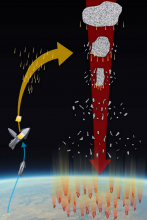Listen to today's episode of StarDate on the web the same day it airs in high-quality streaming audio without any extra ads or announcements. Choose a $8 one-month pass, or listen every day for a year for just $30.
You are here
Hidden Crater
Glaciers keep secrets. They hide rivers, hills, and other surface features. They conceal the bodies of animals that roamed the landscape tens of thousands of years ago, and enfold the debris of crashed airplanes. And a glacier in Greenland has hidden evidence of a cosmic impact — a 20-mile-wide crater blasted out by an asteroid.
Scientists used several lines of evidence to discover the crater, which is below the Hiawatha glacier on Greenland’s northwestern coast. They used radar scans made by airplanes to see through the ice to the ground below.
Those observations revealed a circular basin below the glacier. A peak in its middle rises 15 stories above the basin floor — a common feature in impact craters.
Scientists then collected material that had been washed from beneath the glacier by a river. The samples contained beads of glass that were forged in extremely high temperatures. They also contained quartz crystals that had been squeezed by extremely high pressure.
The evidence points to an impact by an asteroid about a mile in diameter. When it hit, it released as much energy as 700,000 one-megaton nuclear bombs. It would have obliterated any life within a wide range, and produced lesser effects hundreds of miles away. And after effects would have lasted for centuries.
The impact probably happened within the last hundred thousand years, although the exact date is unclear. The glacier will keep that secret for a little while longer.
Script by Damond Benningfield





